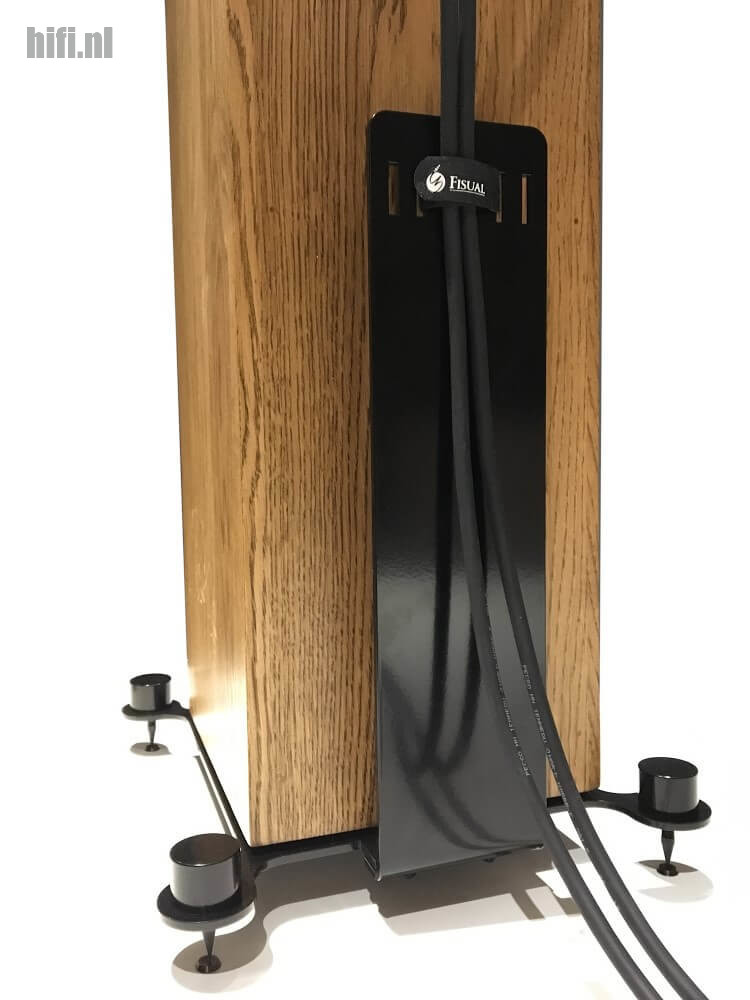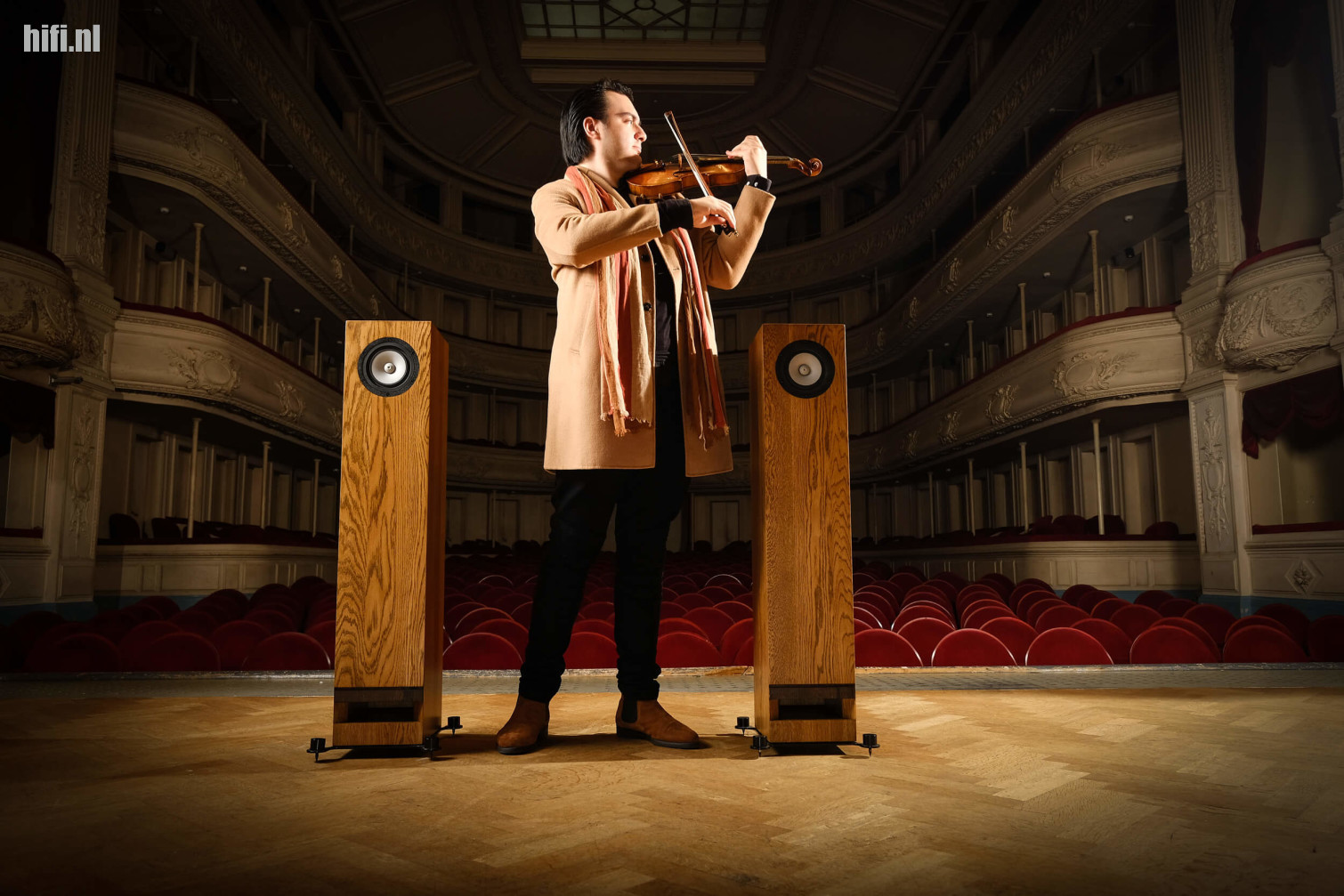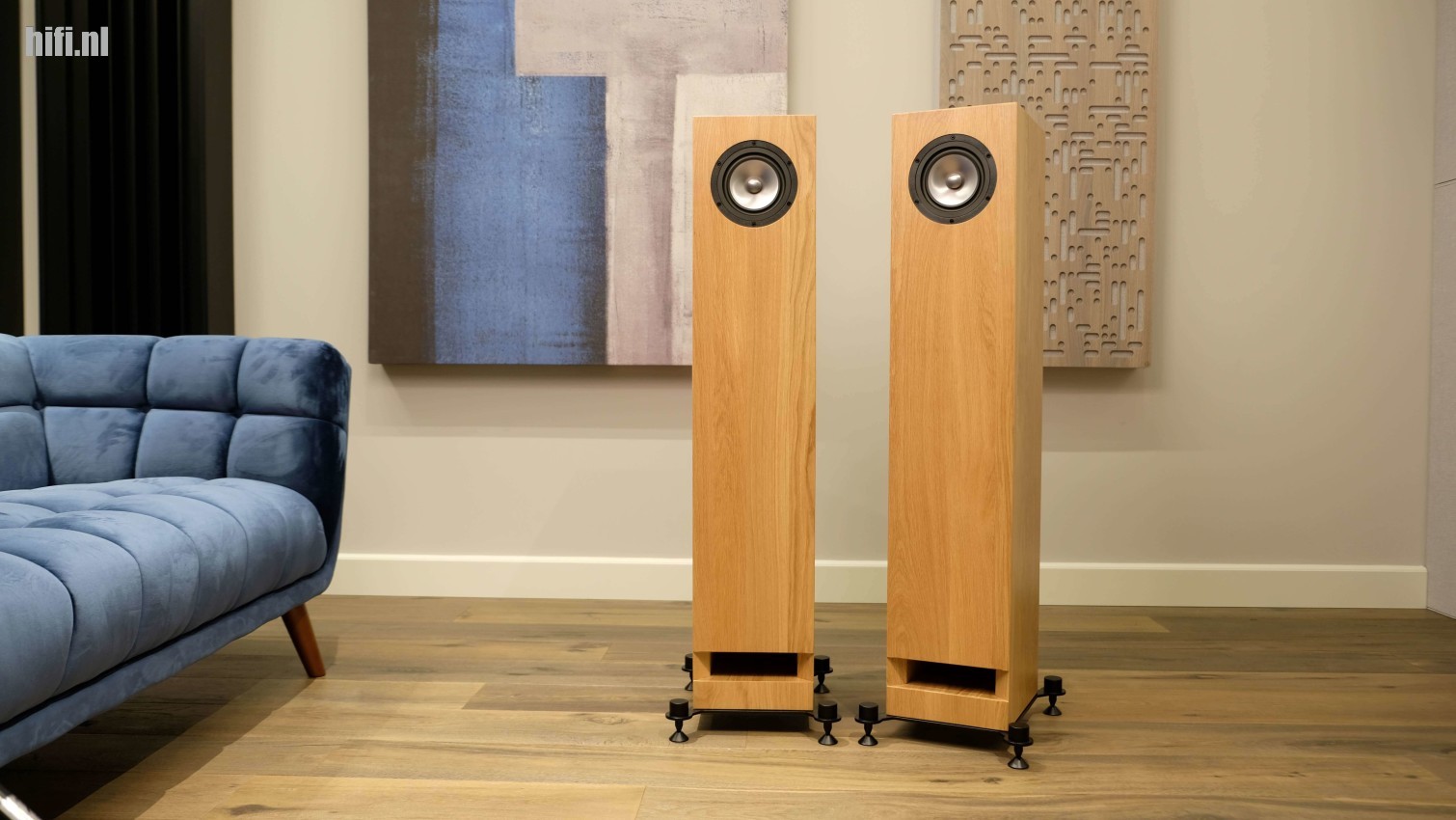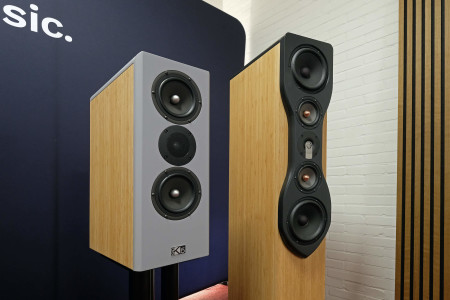
Ask someone to make a drawing of a loudspeaker and you are bound to get a rectangle with multiple circles. A speaker should have about three drivers, no? But British-Belgian brand Pearl Acoustics believes that using a single driver is enough. But can simplicity in design equal a full-fledged listening experience? Time for a (double) listening session with the Sibelius by Pearl Acoustics, also to be heard at the Dutch Audio Event in Veldhoven. | Voor Nederlands, klik hier
Pearl Acoustics
For Pearl Acoustics founder Harley Lovegrove, a loudspeaker must excel in simplicity; complex crossovers and filtering to tune multiple drivers, is not considered as progress. In doing so, the Brit living in Belgium takes a radically different opinion from most major loudspeaker manufacturers, who bet on 2, 3 and even 4-way designs. We recently witnessed a demonstration of the EPIKORE 11 by DALI, an immense floorstander with five drivers.
Then the slim Sibelius with its single and relatively small 100-mm driver really is the opposite. And yes, quite a few loudspeaker designers will raise their eyebrows, because they strongly believe in multiple drivers producing sound within their own optimal frequency range producing sound and working in tandem with each other.
Pearl's premise is that the advantages that flow from such a one-way design are are outweighed by the disadvantages. Typically, in a conventional loudspeaker, music is deconstructed and it does not function as a point source. "I spent years making measurements and building multi-way speakers, only to finally realise that a simple design with one driver sounds better," Lovegrove says about this.
That speaker is the Sibelius, the only loudspeaker Pearl Acoustics manufactures. It is available in many variations in terms of colour and finish ("Any colour is actually possible"), but essentially it is the only model offered by Pearl Acoustics. "I often get requests to make a bookshelf version, but that wouldn't sound so good."

In addition, there is indeed an ambition to play a role in other audio segments. The company already offers its own hi-fi rack and speaker cables and will soon present apair of its own Pearl Acoustics amplifiers. Very typically, the brand will immediately offer two very different products: a highly modified Class D Purifi design with a 'relaxed' DSP-less mode that should deliver a Class A sound and a single-ended tube amplifier with KT170 tubes. Want to build your own amplifiers? That seems an unusual step for a speaker builder, but as we later discovered, amplification has a big impact on the Sibelius. The name? A reference to Lovegrove’s favourite composer.
Lots of choice
It was because of practical reasons that listening to the Sibelius took place at two locations. Firstly in our own test room, where they stayed for a week, then a second session in the beautiful listening room in the Phixum shop, located in the beautiful historic centre of the Flemish Brabant town of Tienen. Not that Phixum is 'just' a dealer of Pearl Acoustics products; there is a much stronger connection with the brand.
Production of the Sibelius takes place in the region and Phixum’s managing director Maxime is also a director of the manufacturing wing of Pearl Acoustics. The brand trades mainly online. However, for interested parties worldwide, there are listening room locations where private auditions can be arranged. These rooms are sometimes at a Pearl partner's premises, but sometimes it can also be in the homes of enthusiastic customers.
Harley Lovegrove may be the inspirer of the brand and speaker, but the company is run by a younger generation. Harley's daughter Summer is CEO with London-based Ajay Verma as technical director, while young Belgian Dries Ceuleers assumes the role of production director. We don't usually talk at length about how a loudspeaker brand is organised behind the scenes, but at Pearl Acoustics we found it so relevant. Although the Sibelius loudspeaker was born out of decades of passion ande xperimentation by Lovegrove himself, it is not a hobby project – but a young, dynamic company with a fresh approach.
Lovegrove remains involved with Pearl Acoustics, alongside the other activities, such as creating content for his very popular YouTube channel, where he discusses hi-fi gear and recordings. He also makes classical recordings and works with charities such as Young Belgian Talent to promote young artists.

Although the Sibelius contains only one driver, that does not mean it is mini-speaker. It remains a floorstander, although it can safely be called a slim one. Its elegant impression is enhanced by its height of almost 110 cm coupled to a small, almost square footprint.
If you then opt for the light oak finish, like the test speakers we auditioned, then you're talking about something surprisingly light and graceful in the room. The speaker is recommended to be used with 'stands', consisting of a base with spikes coupled to a rear cable clamping system.
The Sibelius appearance is very much defined by the single shallow driver mounted high up in the enclosure, set into the front baffle that is otherwise completely mirror-smooth. Only at the base is this flatness broken by a large opening across the fullwidth of the Sibelius acting as a bass sound hole opening; not ‘a port’ according to Lovegrove. This allows that small driver to dive deeper, but there are noturbulence noises. Internally, the cabinet is asymmetrically arranged, which in terms of pressure differences and prevention of standing waves is positive.
12 weeks of work
The Sibelius is a fine example of a loudspeaker where pictures fail to convey its quality and sleekness. In terms of construction and finish, we felt its closer to a piece of furniture than a typical speaker constructed from MDF and decorated with veneers. That impressionmay be because the enclosure of our Sibelius loudspeakers were constructed of solid oakwith a thickness of 3.2 cm. You notice this immediately when you unpack them, because despite the slim lines, each weighs a hefty 23 kg.
Like high quality furniture, the Sibelius enclosure is glued and clamped, a process that takes longer than industrial methods. Its corner joints looked perfect and nice and sharp-looking. This may be why the production of the Sibelius takes twelve weeks from start to finish.

It begins by selecting the wood. Lovegrove repeatedly emphasizes that thecompany is trying to operate sustainably as possible. That was also one of the reasons for choosing oak. Tropical hardwoods would also be acoustically interesting, but "those wood types never have an ethical origin". After the individual cabinets are built, pairs are formed. "It's a natural material, so there is always variation between the enclosures. Sometimes lighter, sometimes darker. When a series of enclosures are constructed, we start matching them, prior to staining and finishing, so our customers get a pair that blend well together. It's always unique though."
For a small speaker maker, Pearl offers an astonishing number of colour options. Besides the lighter oak version that was on display with us, you can also opt for a darkcherry wood stain, wenge or a dark oak variant. But it doesn't stop there. Since this year, white or black is also possible, and you can even choose between a gloss lacquer or a satin finish. Extravagant colours like British Racing Green or a Fire Red are also available, again with a choice between gloss or matt finish.You can even specify your own unique colour, albeit at an additional cost.
The lacquered Sibelius is not made of oak, but of high-grade 24 ply, 30mm thick birch. According to Lovegrove, the idea of adding lacquer coating to natural oak does not seem right and anyway, you can get a much better finish on a birch base than oak. However, birch is not cheaper than oak and the lacquering process is extremely time consuming, so the price of the price of the Sibelius ranges from €5,990 to €7,200 per pair. These are indicative prices, depending on shipping and finishing.
Finally, the icing on the cake in terms of finish is that you can choose between a silver- or copper-coloured drive cone. In terms of sound, they are acoustically identical.
An empty space
There is extremely little in the Sibelius' enclosure. For a start: no crossover, which makes sense with a single-driver design. After all, one function of a crossover is to distribute the incoming signal across the different drivers. That sounds very simple to do, but in terms of crossovers, a lot is possible, making this component have a huge impact on the reproduction. Not only in terms of tonality, but also things like dispersion and phase behaviour.
Because the Sibelius is 1-way, it’s one driver is coupled directly to the amplifier. That can almost be taken literally, because inside the enclosure there is barely even any cabling. The speaker terminals can be found right behind the driver, high up on the enclosure. Between the terminals and the connections to the driver, there is only a modest number of centimetres of cable internally.

According to Lovegrove, one consequence of this minimalist design is that even the loudspeaker cable can have an impact on sound reproduction. We didn't delve into that ourselves; the QED and Boaacoustic cables we use at home seemed fine. Pearl Acoustics sells its own cabling, but when choosing another brand, it is something to be taken into account.
The Sibelius is, as Lovegrove likes to put it, a transducer that attaches directly to an amplifier. The fact that there is no crossover, or step filtering to tweak the sound, means the driver have to be really, really good. Lovegrove also admits that the search for the driver was difficult. In the end, they settled on a modified, light 4,5 inch driver from Markaudio.
Less is more
But how does such a single driver loudspeaker perform? Having heard many dozens of multi-way speakers it was certainly an exciting question to investigate. In our test room, we first coupled the Sibelius loudspeakers to a Primare PRE35 andA35.8 output stage, a Class D system that effortlessly drove the Pearls. The best however, was the little Nait 50, Naim's nostalgia project in honour of their anniversary, also here for review. Like the original Nait, it is very compact and built according to a back-to-basics philosophy, which instinctively suits the Sibelius.
The first thing we noticed was that the Pearl speakers do indeed offer a very differentlistening experience than the speakers we usually encounter. Better or worse? Mostly 'different'. For instance, with a big speaker with lots of drivers, you can get a wall of sound or just get a very deep insight into fine detail, the Pearl Acoustics loudspeakers deliver music in such a way that it detaches from the enclosures.

During Shostakovich's Symphony No.1 in F minor played by the Boston Symphony Orchestra conducted by Andris Nelsons, the listening experience was reminiscent of a largerhall, where we were seated a few rows back from the stage.Beautiful was how the exuberant parts of 'Lento - Allegro molto' were delivered very dynamically, with percussion that really popped. This surprised me because you do not expect from a single full-range driver such a well pronounced low or high.
When we switched to a slower violin solo, not everything fell away but there was room for refinement and detail in the centre. The Pearl’s are not over-analytical in this corner, they are rather a warmer speaker that suits long listening well. So, we were not listening to an ultimate textural image where one hears the bow gliding across the strings more than the music itself. Instead, you experience an overall soundscape that many will surely find more realistic. And perhaps a more relaxed listening moment too.

The Egmont, Op.84 by Beethoven performed by British woodwind formation Boxwood &Brass has long been a great interpretation that we regularly return to. Through the Sibelius loudspeakers, the warm character of the woodwinds is conveyed very convincingly. Again, we had the impression of listening to a concert in a largerlistening space. A church perhaps. Such a live feeling is also aptly conveyed by the Pearls on Vincent Belanger's tango-esque 'Wow!' but equally well on the rougher guitar work on 'Gentlemen' by the Afghan Whigs. Two very different tracks, which in both cases the midrange stood out in terms of quality and soundstage positioning. The double bass on the tango piece and the complex drum playing on Gentlemen also resonated with body and dynamics, which was also very nice.
Choose your amp wisely
Some of these tracks we played again when we visited Pearl Acoustics’ listening room in Tienen. First through a class D amplifier, then through the class A lushness of the Sugden A21SE. That change, in terms of amplification was a real eye-opener. When switching the (otherwise in other circumstances very much appreciated) Primare to the Naim in our own room the Pearl Acoustics loudspeaker delivered a different sound, on this switch however, the difference was night and day night. The performance of any loudspeaker is impacted by the amplifier that drives it, but with the Pearls the difference was downright spectacular.

With Sugden's integrated amplifier – a very traditional Yorkshire brand that we have sympathy for, despite our own preference for newer designs – Boxwood & Brass's Beethoven tracks came completely to life. It almost seemed like another loudspeaker, and instant proof that it's best to marry the Sibelius with the right amplifier.
Another highlight during the listening session: 'Lazarus', found on the latest 'Blackstar'album by David Bowie. A catchy collection of songs for fans, because despite thestaying power and vitality in his voice, you can also hear the end approaching. This song in particular is subdued, a feeling sharpened by the melancholic saxophone and slow strumming guitar, which on the Sibelius are positioned further into the soundstage, with Bowie's voice rendered excellently. We listened completely fascinated by it. But really, it is the overall performance we found ourselves absorbed in, and rendering it effortlessly and stress-free is precisely the strength of the Sibelius.
Conclusion
The Pearl Acoustics Sibelius is something different from the average loudspeaker. We are not just talking about its sleek looks. That's good, because one smaller driver in alarger cabinet looks sleeker than a tower with many units. The Sibelius enclosure isalso built to a very high standard, so it will look in many interiors as a subtle showpiece.
The single driver offers a listening experience that initially surprises. It makes you think about what you are hearing and gradually convinces. It is sometimes surprising how deep the Sibelius can go and how it can handle dynamic peaks so successfully. But above all, it is a listening experience that does not dissect things or coldly isolate instruments from the whole. You could describe it like an evening in the middle row of a fine concert hall. Not everyone will go for this, but quite a few music lovers just might. It’s well worth listening to.
Pearl Acoustics Sibelius
From €5,989 incl VAT, excluding accessories
For current prices, visit www.pearlacoustics.com
(For reference: the team at Pearl Acoustics have calculated that for €6,700 you can have a set delivered to Utrecht, NL (as an example) including shipping and a pair of Sibelius metalstands worth 477.95 euros)
Rating 4.5 out of 5






